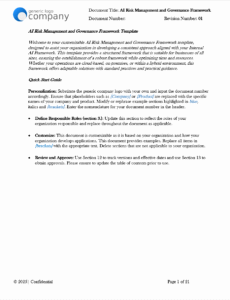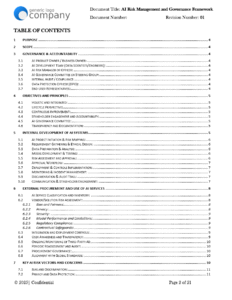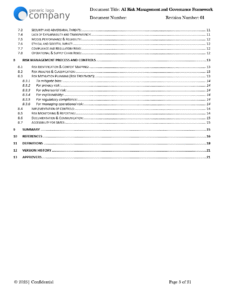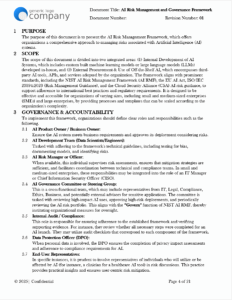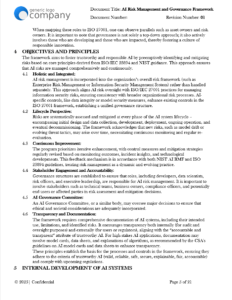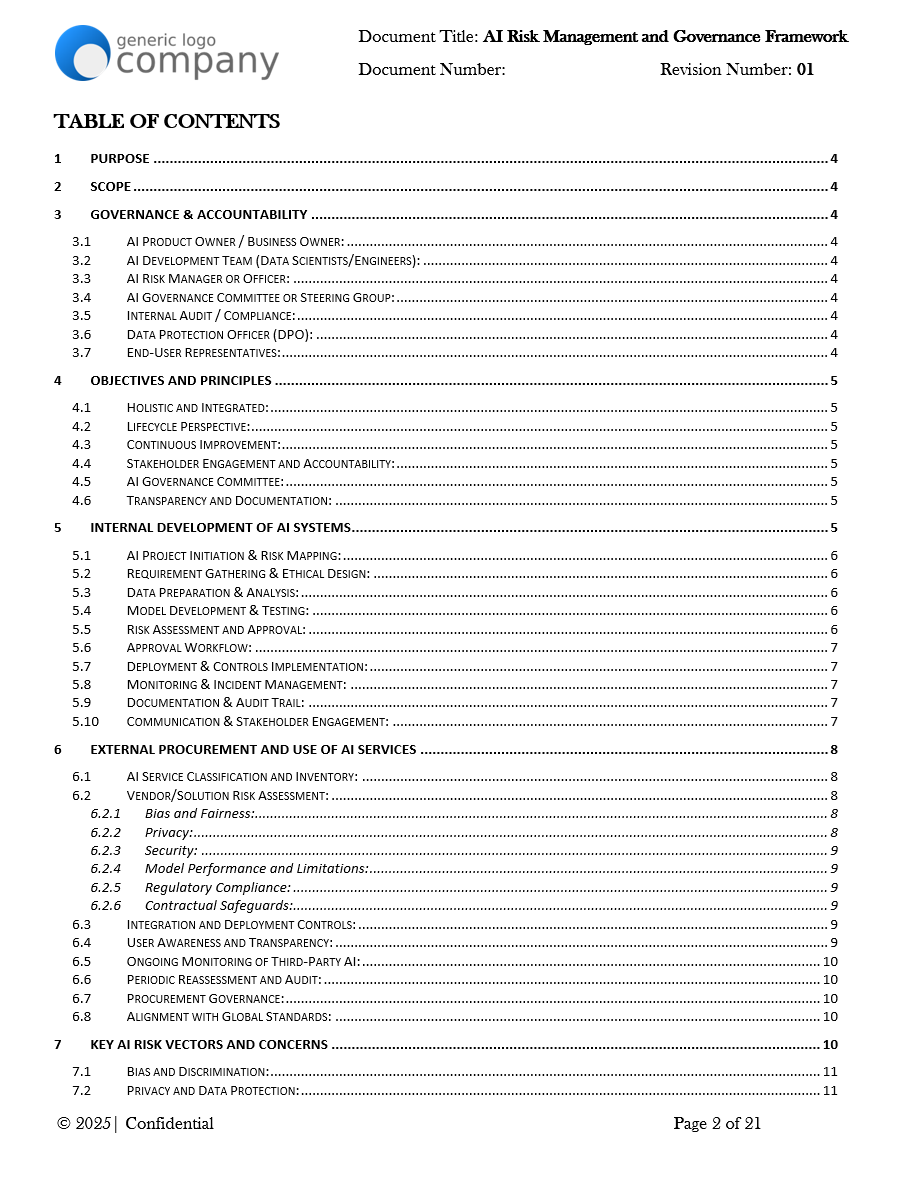
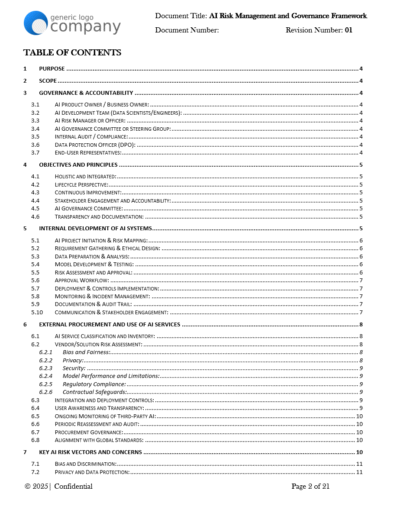
- Version
- Download
- File Size 0.00 KB
- File Count 0
- Create Date August 22, 2025
- Last Updated August 23, 2025
AI Risk Management & Governance Framework Template
Establish an enterprise-wide framework for identifying, classifying, and mitigating AI risks aligned with NIST, ISO, and EU AI Act standards.
Ready to Manage Your Risk?: [Download Now]
AI risk is complex — spanning bias, privacy, security, explainability, and compliance. This framework template provides a structured governance model to manage AI risks across internal development and third-party procurement, ensuring responsible AI deployment and regulatory alignment.
Key Benefits:
-
✅ Compliance-Ready: Structured around NIST AI RMF, EU AI Act, ISO/IEC 42001, and ISO/IEC 27001.
-
✅ Full Lifecycle Coverage: From AI project initiation to deployment, monitoring, and continuous review.
-
✅ Third-Party Risk Control: Includes vendor assessment, contractual safeguards, and ongoing monitoring.
-
✅ Risk Vectors Addressed: Bias, privacy, security, explainability, performance, ethics, and supply chain.
-
✅ Audit-Ready: Includes governance roles, documentation requirements, and audit trails.
Who Uses This?
Chief Risk Officers, compliance officers, AI product owners, and internal audit teams preparing for AI Act conformity assessments, ISO certification, or governance audits.
Why This Matters
Global regulators now require organizations to implement structured risk management systems for AI. Without clear governance, businesses face operational, ethical, and compliance risks. This framework ensures risks are identified, mitigated, and documented in line with internationally recognized best practices.
Framework Alignment
This template aligns with leading global frameworks:
-
NIST AI Risk Management Framework – risk identification, classification, monitoring, and treatment.
-
EU AI Act – governance obligations for high-risk systems, transparency requirements, and conformity assessments.
-
ISO/IEC 42001 (AI Management System Standard) – embedding AI governance into corporate structures.
-
ISO/IEC 23894 (AI Risk Management) – detailed lifecycle-based risk practices.
-
ISO/IEC 27001 – integration of information security into AI operations.
-
OECD AI Principles – fairness, accountability, and human oversight.
Key Features
-
Governance & Accountability: Roles for product owners, data scientists, risk officers, audit teams, and end-user reps.
-
Internal AI Development Controls: Ethical design, model testing, incident management, stakeholder communication.
-
Third-Party Procurement: Vendor assessments covering bias, privacy, security, performance, and regulatory safeguards.
-
AI Risk Vectors: Structured coverage of bias, privacy, security threats, transparency, model reliability, and societal impact.
-
Risk Management Process: Identification → Analysis → Treatment → Monitoring → Documentation.
-
Audit-Readiness: Clear workflows for reporting, KPIs, and documentation requirements.
Comparison Table
| Feature | Generic Risk Policy | AI Risk Management Framework (Professional) |
|---|---|---|
| Mentions AI risk | General | Full lifecycle AI risk mapping |
| Third-party vendor oversight | Minimal | Vendor classification, contractual safeguards, ongoing monitoring |
| Risk vectors covered | Partial | Bias, privacy, security, explainability, performance, ethics, supply chain |
| Integration with standards | Not referenced | Explicitly mapped to NIST AI RMF, EU AI Act, ISO 42001 |
| Documentation & audit support | Absent | Built-in documentation, KPI tracking, audit trail |
| Continuous improvement | Not included | Lifecycle updates, stakeholder engagement, re-assessment process |
FAQ Section (Schema-Friendly)
Q1: Which regulations does this framework align with?
A: The template aligns with NIST AI RMF, EU AI Act, ISO/IEC 42001, ISO/IEC 23894, GDPR, HIPAA, and OECD AI Principles.
Q2: Can SMEs use this framework or is it only for enterprises?
A: It is scalable. SMEs can adopt a simplified version, while enterprises can apply the full governance and lifecycle controls.
Q3: Does this framework cover vendor/third-party AI risks?
A: Yes. It includes vendor risk classification, contractual requirements, and periodic audits.
Q4: How does it address bias and explainability?
A: It includes bias mitigation methods, explainability standards, and stakeholder documentation.
Q5: How often should risk assessments be conducted?
A: The framework recommends continuous monitoring plus periodic reassessments, especially after major updates or regulatory changes.
Q6: How is this different from a generic risk policy?
A: Unlike generic documents, it is compliance-grade, explicitly mapped to global AI frameworks, and includes technical + governance integration.

